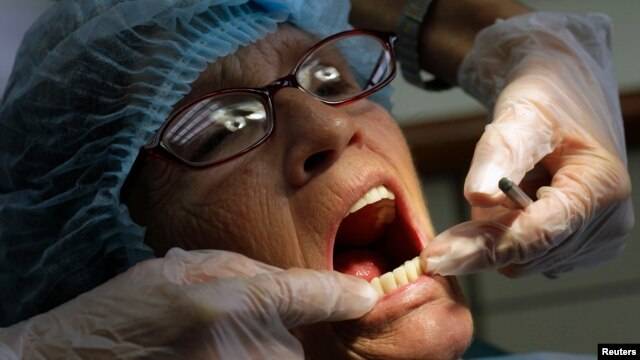Said1
Gold Member
THis artitlce requires a subscription. I linked it, but it can be view by clicking the link.
Link
A Smile So Bright You Gotta Wear Shades
When even the dental hygienist thought I'd gone too far, I started to panic. Next stop, Mexico?
I AM A RECOVERING TEETH WHITENER. As with most addictions, this one began innocently enough. A few years ago I asked my dentist a casual question: "By the way, how much do those bleaching trays cost?"
Like so many of us who have reached middle age, I'd had a serious coffee and black-tea habit for years, and the dullness of my smile had begun to hamper my self-image. I looked in the mirror one morning and thought, This is it.
Had my dentist stuck to the retail cost of about $400, I no doubt would have passed, but as fate would have it, he offered me a deal. Like an experienced car salesman who starts by pushing a stripped-down model because he knows how easily he can work you up to a fully loaded Hummer, he recognized a sucker when he saw one. He had just commented on my type-A flossing technique, noting the sharp lines that etched my gums from overdoing it.
"I'll give them to you for half price. You'll look 10 years younger."
What a ringer. And so he planted the seed that would begin my insatiable craving for whiter and whiter teeth. The trays arrived two weeks later, and I began my daily treatment. This was before the option of overnight bleaching existed, so the trick was to find two consecutive hours when I was not eating or drinking. Food and beverage addictions flew by the wayside as I restructured my routine to reclaim the pearly whites of my youth.
A few days passed and I began to notice improvement. Then the pain began. I tossed down ibuprofen, determined to work through it even though the directions said to stop should any discomfort arise. I didn't want to cut down on my morning java and afternoon chai, so I gritted my throbbing bicuspids and made it through an extra three days. When I began to lose sleep even with the drugs, I reluctantly stopped.
When I visited the dentist some three months later, the hygienist (I'll call her Susan) took a step back. "Whoa! You got those teeth white enough, girl. They're so white, they're almost green."
I couldn't see what she did. To me, my teeth looked slightly muddied again, and I needed more small syringes with which to inject the miracle gel into the trays. A package of those babies cost a whopping $75, but at this point my addiction outweighed money for meals.
But Susan wouldn't sell me any. Not only that, but she has had me on restriction now for more than two years. The last time I was there I peeked in my file (I read it upside down from across the room when she stepped out) and saw that she had noted the dates of my purchases, and scribbled "No more than twice a year" in the margin. When I heard the rustling of her return, I quickly lay back down, rearranged my paper bib and closed my eyes in an attempt to conceal my consternation. Was she trying to wean me off? Would I have to go to Mexico to get the stuff?
Fortunately, science has kept pace with my needs. We may not have cured cancer, but we now have an infinite supply of every kind of whitener imaginable, all on the drugstore shelf. There are strips, pastes, pens, and I've even seen the injection package I used to have to get from Susan.
I'll never be brave enough for Botox and am, by principle, opposed to plastic surgery, but boy, are my teeth bright! When I was recently remarried, the one question circulating among the reception guests was, "How does she get her teeth so white?" People have no idea how remarks like that can set me back. When I recently colored the gray in my hair, my husband was complimentary. "It brings out the color in your eyes, and your teeth look even whiter!" Bingo. How could he know that every nerve in my body tingled as I immediately wondered if I should color my hair more often?
I suffered another backslide when I discovered a set of whitening trays on my husband's side of the bathroom. Was he trying to outdo me with a whiter smile? Three months later, he has yet to use them, and the wave has subsided. I am well into recovery now. My teeth look acceptable to me for longer and longer periods of time. I refresh them only every few months, and when I feel the very first pulse of pain, I close the tray box and put it back in the drawer. I've been on that bad trip, and I won't go there again.
Crucial to victory, however, is that I try never to go into the dental aisle of the grocery store alone. Friends and family escort me directly to the toothpaste or floss, as I avert my eyes from the ever-widening selection of whitening products.
Of course, I haven't told them I'm now hooked on the electric, circular toothbrushes that make my teeth shine, or that I massage my gums for a full two minutes to prevent stain buildup. And then there's the whitening mouthwash I gargle with after I brush--that bottle I just toss under the groceries in my cart. They never even know.
PHOTO (COLOR): THE FAIREST OF THEM ALL: I didn't want to cut down on my morning java so I just gritted my throbbing bicuspids
~~~~~~~~
By Kathleen Clary Miller
Link



